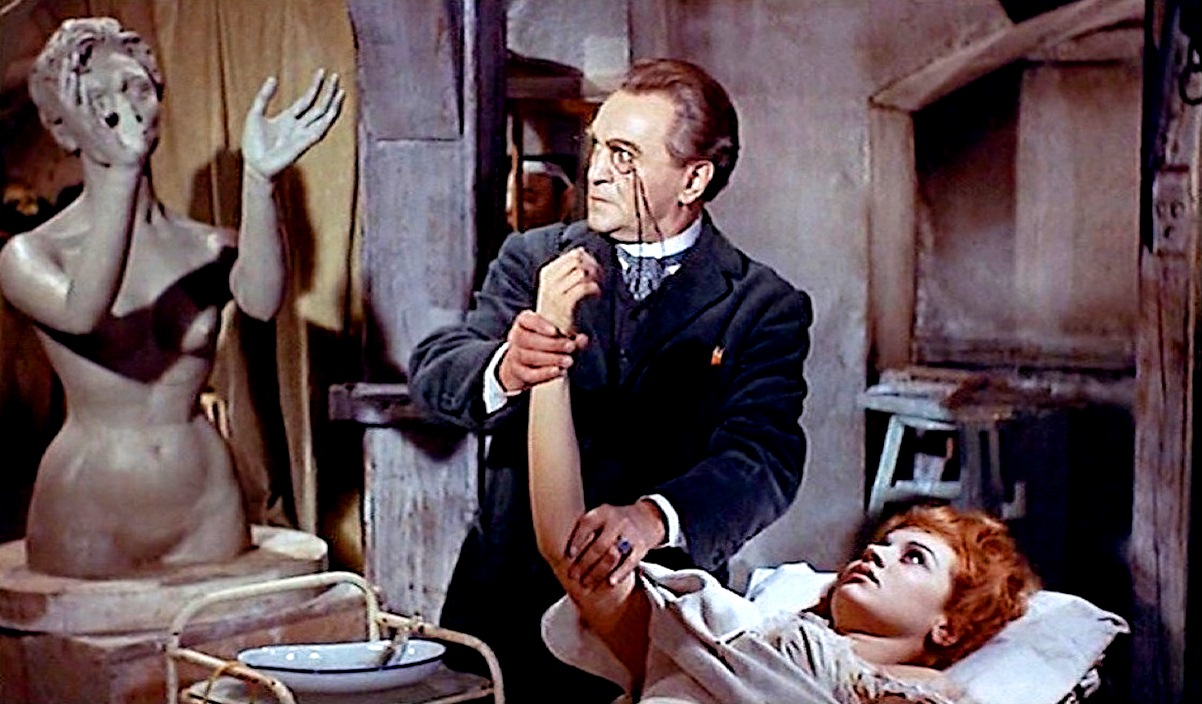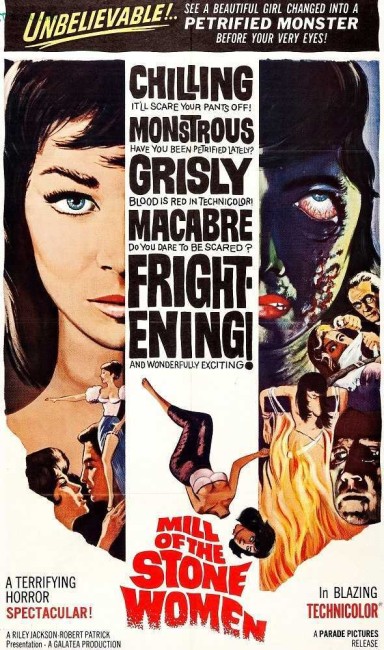(Il Mulino Delle Donne di Pietra)
Crew
Director – Giorgio Ferroni, Based on the Short Story by Peter Van Wiegen, Producer – Gian Paolo Bigazzi, Photography – Pier Ludovico Pavoni, Music – Carlo Innocenzi, Production Design – Attigo Equini. Production Company – C.E.C. Films/Galatea Film/Explorer. Film ’58
Cast
Pierre Brice (Hans von Arnim), Scilla Gabel (Effie Wahl), Wolfgang Preiss (Dr Loren Bohlem), Danny Carrell (Lisolette), Herbert Boehme (Professor Gregorius Wahl), Liana Orfei (Annelore), Alberto Archetti (Konrad)
Plot
The Netherlands, the 19th Century. Hans von Arnim arrives in the small town of Veeze to visit Professor Gregorius Wahl. Hans is assistant to another professor who is about to publish a monograph about the carousel in Wahl’s mill where mannequins are used to displays scenes of horror from history. Wahl permits Hans to return over the course of a week to write up his notes. Hans meets Wahl’s daughter Effie who begs him to return to her in secret at night where the two become lovers. Hans tries to break it off, realising that he loves Lisolette, a local girl that he knew as a child, only for Effie to collapse dead moments later. The professor is greatly upset at the news. Hans then returns only to discover Effie alive again and everybody denying that anything happened.
Continental Gothic is a term used on this site to apply to films that emerged principally from Italy (but also other European countries) during the 1960s. These drew on the influence of Hammer Films and Roger Corman’s Edgar Allan Poe adaptations but created their own unique style shot in moody black-and-white, featuring mad aristocrats, supernatural retributions and resurrected witches and set in decaying castles and mansions. Many of the films also featured British actress Barbara Steele whose haunting wide-eyed beauty became an indispensible fixture of the genre.
Mill of the Stone Women came out not long after the work that propelled the Continental Gothic into high gear – Mario Bava’s Black Sunday (1960). It came at the point where many of the aspects of the cycle had not been set in place and so it is somewhat different in tone to the films that followed. For one, it is in colour when most of the other Italian works were in black-and-white.
Like Mario Bava, Giorgio Ferroni has drawn his inspiration from the Hammer films that had kicked off a trend just a couple of years earlier with The Curse of Frankenstein (1957) and Dracula/The Horror of Dracula (1958). There is the same lushness of mood and colour photography, the emphasis on the richness of the set dressings that made the Hammer films such distinctive works.

What makes Mill of the Stone Women stand out is the colour photography and the production design. The mill’s most striking set-piece is the carousel where we see mannequins moving around in a circuit depicting various tableaux of witches at the stake, women being hung, poisoners and a representation of Kali. These are vivid and striking. Elsewhere every corner of the mill seems filled with bric-a-brac and mannequin parts hanging and protruding from the wall in eye-catching ways.
The downside of Mill of the Stone Women is that it is far more sedate in terms of pace than the Hammer films or other works of the Continental Gothic were. It sets up a mystery but there is not much in the way of payoff until the third act when [PLOT SPOILERS] we get to Scilla Gabel’s mysterious death and return to life again. While the title leads you to expect something supernatural, the eventual denouement goes off in the direction of a mad scientist conducting rejuvenation experiments with his daughter. Added to the mix is a twist borrowed from Mystery of the Wax Museum (1933) and its remake House of Wax (1953) with the scientist draining women of their bodily fluids and turning their corpses into the mannequins on his carousel.
The film was release in a dubbed version in the US in 1963. The credits of the English language version make claim to be based on a story from a collection called Flemish Tales by Peter Van Wiegen. In fact, the book and Van Wiegen do not exist and were made up by the publicity department.
Trailer here


